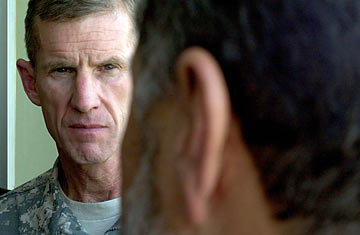
Following the murder of the chief of police and an outbreak of fighting by insurgents in the city's streets, General Stanley McChrystal, newly appointed head of forces in Afghanistan, is briefed by an Afghan National Army commander at a base in Kandahar
As commander of NATO's International Security Assistance Force (ISAF) in Afghanistan, U.S. General Stanley McChrystal has inherited a 7½-year war that appears to be getting worse. Yet U.S. Congressmen have given him only a year to turn it around. In a wide-ranging interview with TIME magazine on the back porch of his office at ISAF headquarters in downtown Kabul, McChrystal discussed his new approach to the Afghan fight, why the military alone can't be a solution and what he's currently reading on his new Kindle.
TIME: Tell me how the operation in Helmand is going.
General McChrystal: It's too early to predict success. They just started.
How would you define success?
What we are trying to do is change the dynamics in the area where we are operating. The current operations that you are hearing about in the Helmand River valley are aimed at areas that are major population centers. They were also areas under Taliban control. They are also a nexus of the poppy trade. So if you describe the Helmand River valley as the breadbasket of the poppy trade and where the Taliban gets a lot of resources and support, what we are trying to do is take the area away from it.
The operations are not aimed at the enemy force — they are aimed at taking away the population from the enemy. As you know, in classic counterinsurgency, if they lose access to the population, they lose. That is what we are focusing on.
So how do you measure that?
It takes time. First thing is, if you take a very small area, you have to try and figure out what is going on in that area. First you have to understand what's going on. It's like knowing what is going on in your neighborhood. Not just the traffic on the road, but how money is made, who is running rule of law, who do they go to when they have dispute adjudication — do they go to a Taliban shadow court, a government of Afghanistan official entity? So you try to look at a whole range of things. There are some overt indicators, close of traffic, commerce, people's ability to interact. Then there are many more that are subtle — you have to get at the attitudes of the people. And that is why I say you have to immerse yourself in it and understand it before you can confidently assess it.
The Helmand op was in the works long before you arrived. Did you just rubber-stamp it, or did you change it?
I actually don't have a rubber stamp. I have to get one. I went down and sat down with the RC South commander, and I didn't put specific changes to timelines or where forces were going, but we talked a lot about the coin intent and the purposes of the operation and the importance of the hold and build — we can clear anywhere we want, but holding and building are hard — so ensuring that the ANSF [Afghan National Security Forces] come in with the Marines, so that they do the partnership up front and in the hold and build. We talked a lot about that, to ensure that we are moving in the right direction there.
There is an awful lot of energy moving towards protecting civilians, but you can't have too much energy. I believe that I have emphasized that across the force, which has probably reached some people, it is my intent to do that. So I think that is a major evolution and shift in the way that we do business.
The p.r. release on Helmand op — no indirect fire, no bombardments? Where did this come from?
I don't know if they are reading my mind, but they are certainly following my intent. If you think about going into an area to protect the population, if you go into an area and no shots are fired but you achieve control, the population is going to feel a lot better. On the other hand, if you come in and you destroy buildings, homes, you may take the ground, but the population is left impoverished — they may have suffered casualties among their civilians — and then to turn and ask for their support, it will be different. So what we really want is the equivalent of a peaceful takeover, where the Taliban are forced out.
But such a public message on the use of arms?
Why shouldn't I? I want the Afghan people to know what we are about. I am not scared about the Taliban knowing that we are going to go protect the population, because at the end of the day, they can't stop us. They can resist that, but they can't stop us from doing that. So I think everyone knowing that that is our intent reinforces with the Afghan populace that obviously we are on their side. But it also reinforces in our force that that is the important thing. It's not killing Talibans, it is protecting the population and giving them the opportunity to smooth their way.
This isn't just for the duration of this operation, but the remainder of the war. They are not prohibited [from using aerial bombardment], and there are cases where we will absolutely use kinetic operations, and there are times when that will be required. But that will not be the objective. We will do that when we have to, not as our going-in precepts.
